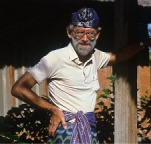 |
CULTURES IN CONTEXT Bali: Ancient and Modern 7. Entertainment : 075-087 |

075. Cock-fighting is a form of entertainment, but there are others … both ancient and modern. Today villagers can, if they wish, choose television or cinema for high-tech entertainment. |
076. But shadow puppet shows (wayang kulit) have enthralled young and old alike for hundreds of years, and they are still popular. The puppeteer sits behind a screen, on which shadows are cast using light from an oil lamp. The puppets are made from buffalo hide, and are said to have magical powers. |
077. Most such shows tell stories about the struggle between good and evil, and it's easy to tell which is which. The good guys appear from the right of the puppeteer, the bad ones from the left. Any of you who have seen puppet shows (like “Punch and Judy”) will know from experience how they can convey messages of good and bad, right and wrong. |
078. Music and dancing are other ancient art forms that have not only survived but gained an international audience by way of tourists ... even though Balinese dancing is basically a religious activity. The dancers are not allowed to show any emotion, as they are supposed to be possessed by spirits during the dance. Traditionally girls began their training when they were four, were considered to be at their best at 7, and retired at 12! |
079. The music is provided by a gamelan, or orchestra of percussion instruments… plus a flute or two. The dominant instrument is a xylophone, with small hammers used to strike metal bars positioned over resonators made of bamboo. |
080. They also have sets of bronze gongs, plus drums to maintain the rhythm. They have no written music. All of the pieces are oral and hereditary, remembered from one generation to the next … though newly composed pieces may be added to their repertoire. |
081. Neither the dancers nor the musicians are professionals, … just ordinary people who practice after work, like Wayan's father … who will also teach his son how to play the instruments involved. |
082. Most dances illustrate stories from ancient mythology, handed down from generation to generation. They tell of gods coming down to earth in human form … |
083. Of kings and prime ministers who struggle to maintain their moral authority in the face of attacks from evil spirits … |
084. Of warriors who grapple with demons in hand-to-hand combat … |
085. And of a prince who was unlucky enough to fall in love with an angel disguised as a human being. |
086. When I as a child in England I was taken to pantomimes like “Peter Pan and “Where the Rainbow Ends”, which in much the same way focused on the struggle between good and evil. This type of theatre has been displaced by film and television in the Western World but the people of Bali are proud of their heritage and have been far slower than most to switch allegiance to the values promoted by Hollywood and Macdonald’s. The face of this friendly barong features in processions as well as stage presentations, at the front end of a long body with several pairs of legs. |
087. The appearance on stage of the she-devil or evil witch rangda served to threaten and/or encourage Balinese people to seek good rather than evil. For hundreds of years in Europe similar '"morality plays,” were taken from village to village before people could read and write. |
![]()
Text, photos and recordings
by John Tyman
Intended for Educational Use
Only.
Contact Dr. John Tyman at johntyman2@gmail.com
for information regarding public
or commercial use.
![]()
www.hillmanweb.com
Photo processing, Web page layout,
formatting and hosting by
William
Hillman ~ Brandon, Manitoba ~ Canada